You’ve planned a motorcycle road trip for weeks, but when you open the garage door, you see it. Your motorcycle has a flat. For an experienced rider who knows how to change a motorcycle tire, this might be a simple fix. If you’re not sure, it helps to learn what to do to replace your bike’s tire.
To get you on the road again, here’s how to change a motorcycle tire[1] in eight steps .
Raise the end of the bike to lift the wheel off the ground. Use a socket to loosen and remove the axle. Release the chain and remove the brake caliper. Put your axle back in place to hold the caliper’s position.[2] It’s a good idea to consult your owner’s manual to learn any steps to take that are unique to your bike’s make and model.
To deflate the tire[3], unscrew the cap on the valve and remove the valve stem core with a special tool. Some valve stems come with built-in caps instead of separate pieces.
When you wondered how to change a motorcycle tire, you might not have realized that you need motorcycle tire changing tools. However, you don’t want to damage your valve stem by trying to remove it with something random from the garage. If you don’t have one already, pause the project and head to your local auto supply store to get a valve core remover.
The bead is the inner edge of the tire where it meets the rim. At the auto parts store, you can also purchase a bead breaker tool to make the job easier. Try to find one with tire spoons, which you’ll use to wedge the tire off the rim.
Insert the tool between the tire and wheel rim and move the tool around the bead. Flip the tire over and repeat this process on the other side. You can use a spray silicone lubricant or glass cleaner to prevent the bead from re-sticking as you move the tool around.[4]
Carefully insert a tire spoon under the bead and push down to pull the tire up. Leave a tire spoon in the spot where you pulled up the tire in order to hold it in place.
Leave a tire spoon in the spot where you pulled up the tire in order to hold it in place.
Use a second tire spoon to pry the tire away from the rim several inches from the first tire spoon. Leave the second spoon in that spot. Retrieve the first spoon and move it a couple inches. Repeat this until the entire tire separates from the rim. Then flip the wheel and repeat the process on the other side.
Alternative step: If your tire has a tube, you’ll need to unbolt the valve stem from the rim and remove the old tube.
Wipe out the inside of the rim and the inside of the new tire to ensure there’s no debris. Coat the edges of the new tire with bead lube. Hand sanitizer or hand soap work in a pinch too.[5]
Alternative step: If your tire has a tube, insert the new, uninflated tube into the tire. Be sure to insert the valve stem into the hole in the rim.
Use the tire spoons to carefully wedge the entire tire under the rim on one side.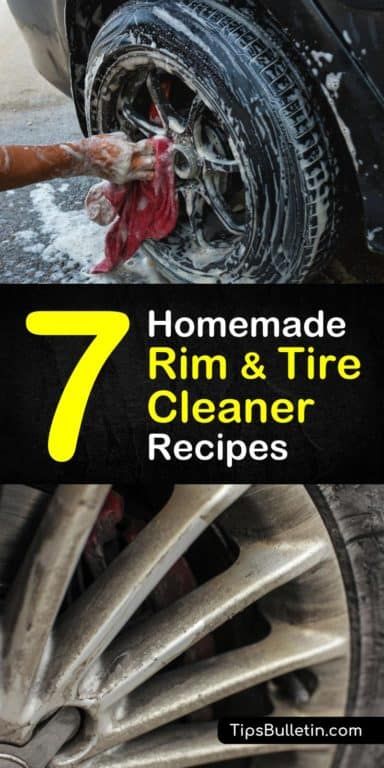 Flip the wheel over and repeat this process on the other side.
Flip the wheel over and repeat this process on the other side.
Fill the tire until it’s completely sitting along the rim. Be sure to check the air pressure. You might have to inflate the tire past the recommended riding pressure number.[6]
Follow your user manual’s instructions to remount the wheel. Check the air pressure again and adjust the alignment of the rear wheel and chain tension.[7] Ensure that all the fasteners are tight before you head out.
Owning a motorcycle offers great recreational opportunities, but it also comes with responsibilities. From insuring your motorcycle to maintaining it, remember to set aside time to properly care for your bike and learn motorcycle riding safety tips. Before you head out on your next adventure, talk to an insurance agent to make sure your motorcycle has the level of insurance coverage you need.
[1] https://www. cycleworld.com/how-to-change-a-motorcycle-tire/
cycleworld.com/how-to-change-a-motorcycle-tire/
[2] “How to Remove Rear Motorcycle Wheel,” YouTube (September 4, 2016).
[3] https://www.rideapart.com/articles/245897/how-to-change-motorcycle-tires/
[4] https://www.cycleworld.com/how-to-change-a-motorcycle-tire/
[5] https://www.rideapart.com/articles/245897/how-to-change-motorcycle-tires/
[6] https://www.rideapart.com/articles/245897/how-to-change-motorcycle-tires/
[7] https://www.motorcyclistonline.com/how-to/how-to-check-front-and-rear-motorcycle-wheel-alignment-mc-garage-tech-tips/
Common Tread Supreme Ruler Lance made one of his regular sojourns to ZLA headquarters in Philly from his lair in Ohio in early fall. Although he was up for the trip, his tires were not. His rear Dunlop had seen better days, so he took a little detour up the hill to Lemmy Mountain for some tire attention before making the ride home.
Our first order of business was to eat the doughnuts Lance brought, washing them down with coffee. If you’re swapping tires before 9 a.m., we recommend you do the same. (If it is after 9, please swill beer instead.)
If you’re swapping tires before 9 a.m., we recommend you do the same. (If it is after 9, please swill beer instead.)
For some reason, we don't always feel comfortable handing off our tire-changing jobs to the "professionals." Photo by Lance Oliver.
Lance's editorial comment #1: Lemmy likes to dive right into a job, but I like to think about the meaning of it all. Such as why do I always change my own tires? There are a couple of good reasons. First, you can save money by buying your motorcycle tires from RevZilla at a good price, probably better than what your local shop charges. Plus, you'll save the fee for changing them. With shops charging $20 to $40 per wheel, the equipment you buy to do it yourself will pay for itself before long. The second reason is that you'll save yourself some time, and that's even more valuable to me than money. I can change my own tires faster than I can make an appointment, take the wheels off the bike, take them to the shop and wait for someone to do the work. I do it on my own schedule, when it's convenient for me.
I do it on my own schedule, when it's convenient for me.
I should also specify that everything here is about changing tubeless tires. If Lemmy ever gets out and rides his neglected Honda XR650L enough to wear out the OEM tires, maybe I'll be able to get him to do a how-to on changing tube-type tires. Now I'll hand the mic back to Lemmy...
Too many trips across Pennsylvania flat-spotted this rear tire. Before making the 475-mile trip home, Lance wanted a new one. We used jack stands to raise the bike. Photo by Lance Oliver.Our first task was to get the rear end of the bike up in the air. There’s lots of methods for lifting a scooter: bike jacks, ratchet straps to overhead rafters, centerstands, wheelstands, you name it. I’ve even changed tires with a bike frame up on a log before, and I’ve laid them on their sides as well. Be creative, but be careful. Lance set his bike up with a pair of swingarm spools at some point, so we just picked up the machine and put it on some plain old automotive jackstands.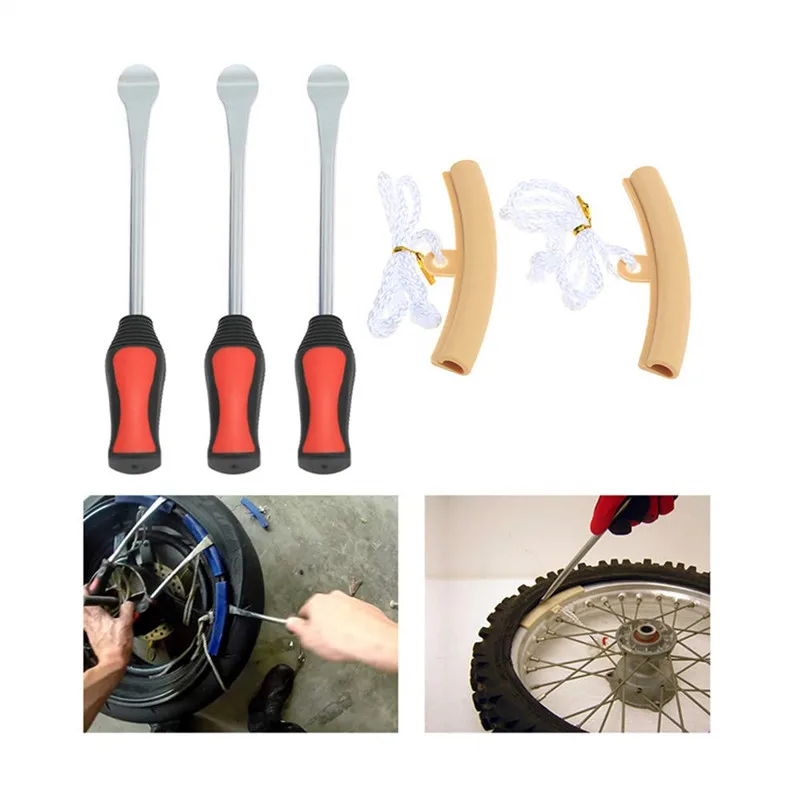 We did loosen the axle nut slightly while the bike was still solidly on the ground. No need to torque on it after it's raised.
We did loosen the axle nut slightly while the bike was still solidly on the ground. No need to torque on it after it's raised.
Lance's editorial comment #2: I have the swingarm spools because at home in my own garage, I'd quickly and easily raise my Versys on my rear stand. Since Lemmy only rides Shovelheads, choppers of muttly lineage and other odd junk, to which no one has ever fitted swingarm spools, he didn't have a rear stand. The jackstands worked just fine.
Next, we loosened the chain adjusters so we could slip the chain off the sprocket, and then slid out the axle. Keep track of the order of the axle hardware, especially wheel spacers. If you fail at this step, you have to put together a little jigsaw puzzle when you reassemble everything.
Lance's editorial comment #3: My tip: I like to put the spacers back on the axle in the proper order and put the nut on loosely. That keeps me from forgetting what goes where and misplacing any pieces. Plus, make a note of where the brake caliper mounting bracket fits into the scheme.
Plus, make a note of where the brake caliper mounting bracket fits into the scheme.
Lemmy uses a drift to coax out the axle. Photo by Lance Oliver.
Rather than let the brake caliper's weight dangle on the brake line, Lemmy suspends it using a bungee cord. Photo by Lance Oliver.Before sliding the axle out, I like to put a little chock of wood under the tire being removed to hold it up. Then I use a drift punch to drive the axle out of the wheel. If you’re doing a front wheel, the process is the same (don't forget to loosen the pinch bolts at the bottom of most fork legs), but you will probably have to remove both brake calipers to remove the wheel. Wire the calipers up out of the way. Don’t let them dangle by the brake hoses.
If you’re so inclined, now is the time to check those wheel bearings. If they feel gritty, repack or replace ‘em! Don’t forget to check the brakes while you’ve got them off, as well.
Deflate the tire by removing the valve core with a valve core tool. After the air has made its exit, it's time to break the beads. There are a multitude of ways to do this, but we elected to use a manual bead breaker. It makes quick work of an otherwise-difficult job.
After the air has made its exit, it's time to break the beads. There are a multitude of ways to do this, but we elected to use a manual bead breaker. It makes quick work of an otherwise-difficult job.
This bead breaker tool Lemmy has works well. A variety of tools, from clamps to levers and wedges, are available for the job. Photo by Lance Oliver.
Lance's editorial comment #4: Breaking the bead can be the hardest part of the job, in some cases. The tool Lemmy has worked like a charm. At home, I have a Harbor Freight changing stand I bought years ago. It has its drawbacks and doesn't get much respect from tool aficionados, but it has a bead breaker that works well, and that alone makes it worth its cost, to me. There are some other nifty tools that don't cost a fortune.
After the beads are broken on both sides, it's time to begin pulling the tire off the wheel. This part of the job is more of an art than a science. Everyone seems to find their own way of doing things. I like to work on old squares of carpet to keep from beating the tar out of the finish on the wheels.
I like to work on old squares of carpet to keep from beating the tar out of the finish on the wheels.
Lemmy gets down there with the wheel, like an old-style wrassler. Photo by Lance Oliver.
Lance's editorial comment #5: Although it was mildly alarming to watch Lemmy battling my wheel and tire on his knees like an Everglades 'gator wrestler, I have to admit his methods got the job done. Personally, my knees have a lot more miles on them than Lemmy's and I prefer to work standing up. Plus, having the wheel clamped to a stand makes it easier to avoid the possibility of putting pressure on a brake rotor. If you do use the Lemmy method, keep the rotor side up to avoid leaning on it.
There are ways to make your own tire-changing stand, if you're lacking funds to buy one. I've seen some good homemade tire-changing setups created with a few dollars of materials: A discarded car wheel with a section of old garden hose sliced lengthwise and put on the wheel's rim for rubber protection, and a threaded rod in the center to clamp your motorcycle wheel to the car wheel.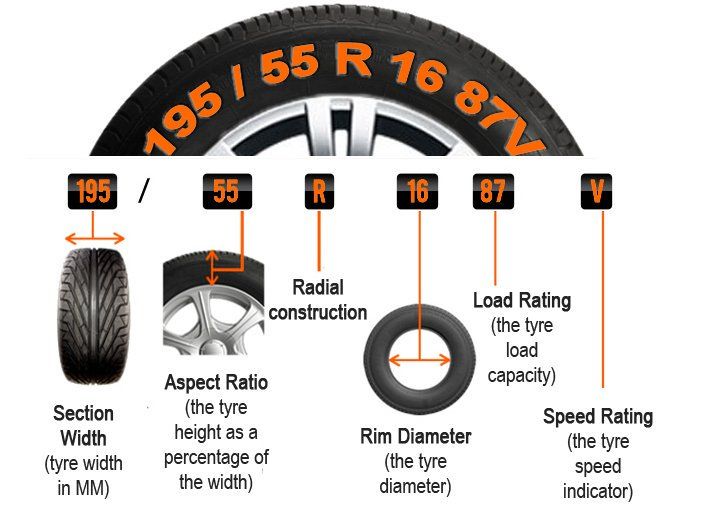 My store-bought tire-changing stand is another option. If you're ready to pay more, I've seen people change tires in a flash without breaking a sweat using one of those fancy (and pricey) No-Mar changers.
My store-bought tire-changing stand is another option. If you're ready to pay more, I've seen people change tires in a flash without breaking a sweat using one of those fancy (and pricey) No-Mar changers.
The job will go easier with the right tools. Use tire lube. They make this stuff for a reason — it works! It helps with de-mounts as well as mounting, and protects the bead from rips or tears from the tire irons.
Use dedicated tire spoons. I’m not going to kid you and say I’ve never fudged it with the wrong tool, but I’ve also ruined some wheels half-assing the job alongside the road in the middle of East Jabip. Rim protectors are a great idea if you want to keep your wheels looking good. If you think I’m just pitching stuff we sell, let me dispel that notion: You can easily cut up old milk jugs, or you can use College Lemmy’s impromptu rim-saver: heater hose scraps filched from the auto parts joint.
Removing the tire is prolly the trickiest step. Use the spoons, take your time, and as Lance kept reminding me, “Take small bites!” He’s got a great point. I have a habit of getting greedy. I try to de-mount the whole dang tire at once, and it never works. It bends the spoons, makes my arms sore, and puts the delicate beads at risk. Work smart, not hard. Do little sections of bead at a time and don't forget the tire lube.
Use the spoons, take your time, and as Lance kept reminding me, “Take small bites!” He’s got a great point. I have a habit of getting greedy. I try to de-mount the whole dang tire at once, and it never works. It bends the spoons, makes my arms sore, and puts the delicate beads at risk. Work smart, not hard. Do little sections of bead at a time and don't forget the tire lube.
With one bead off the wheel, it's easy to see the drop-center and understand how it makes this whole process possible. Photo by Lance Oliver.Here's the most important thing to remember. The act of levering the bead over the rim lip only can happen if the bead is in the “drop-center” on the opposite side of the tire. The drop-center is the shallow channel that runs the circumference of the wheel at the center and it makes the whole process possible. If you're having to use excessive force and still can't get the bead of the tire over the lip of the rim, your problem is that the tire bead is not in the drop-center.
It can be difficult because the tire doesn't want to stay in the drop-center. I typically kneel on the tire to keep it where I want it. At this point, after a few bad words, you should have one bead free of the tire. Repeat the process on the other bead, but the same side of the wheel.
Lance's editorial comment #6: I find that having a couple of different shapes of tire irons makes the job much easier. I have one long iron with a nice bend in it that's almost indispensable for that first grip on the second bead, which is harder to access than the first.
With the tire off, I give the wheel a visual inspection, and then replace the valve stem. You can either pull the old one out with a tool or just cut it out. Lance didn't have a replacement valve stem ready, so we reused the same one. You can do that, but replacing it is cheap protection.
Almost done. Rim protectors keep wheels from getting marred by tire irons. Photo by Lance Oliver. Using the directional arrows on the sidewall, check and double-check the direction of the new tire relative to the wheel. Nothing is worse than mounting it backwards and having to do the job twice. Be generous with the lube and slather the new tire’s beads. Installation of the new tire is much the same as removing the old one. Again, “take small bites” and be sure the opposite bead is in the drop-center of the wheel. If there's a small dot of paint on the sidewall, that's the balancing mark. Line it up with the heaviest part of the wheel, typically where the valve stem bolts in (see balancing section below).
Using the directional arrows on the sidewall, check and double-check the direction of the new tire relative to the wheel. Nothing is worse than mounting it backwards and having to do the job twice. Be generous with the lube and slather the new tire’s beads. Installation of the new tire is much the same as removing the old one. Again, “take small bites” and be sure the opposite bead is in the drop-center of the wheel. If there's a small dot of paint on the sidewall, that's the balancing mark. Line it up with the heaviest part of the wheel, typically where the valve stem bolts in (see balancing section below).
Once the tire is mounted onto the wheel, you need to seat the beads. Remove the valve core from the new stem so you can inflate it faster. A large air compressor will have enough oomph! to blow the beads of most tires onto the wheel, but there are always kludgy exceptions. If your compressor’s not doing the job, there are a number of redneck ways to make the tire assume its new home. I’m not going to claim that I’ve never used ether to blow a bead onto a wheel, but I sure am not recommending anyone else do it. Bead seating tools (also known as Cheetahs) are much less dangerous. Watch your fingers during this step! I have pinched the ever-livin’ bejesus out of myself by getting my finger too close to a bead that was about to seat.
I’m not going to claim that I’ve never used ether to blow a bead onto a wheel, but I sure am not recommending anyone else do it. Bead seating tools (also known as Cheetahs) are much less dangerous. Watch your fingers during this step! I have pinched the ever-livin’ bejesus out of myself by getting my finger too close to a bead that was about to seat.
Lance's editorial comment #7: Lube is again your friend when trying to seat the beads. It encourages the bead to slide into its home and, because it is liquid, it will create tell-tale bubbles to show you where air is escaping, instead of inflating your tire. Sometimes pressing on the tread next to the spot where air is escaping past the bead will be enough to get that satisfying and loud "pop!" you're seeking.
With the bead set, replace the valve core and adjust the inflation to the correct pressure. If you are the balancing kind of fellow, now is the time to do so. (Lance and I have similar views on balancing tires. We don’t.) Please don’t leave murderous comments about balancing. I encourage everyone to do what they feel is best with regard to tire balancing.
We don’t.) Please don’t leave murderous comments about balancing. I encourage everyone to do what they feel is best with regard to tire balancing.
Lance's editorial comment #8: Uh, actually I've been known to balance tires, especially front ones and especially on a bike I'm going to take to the track and ride at higher speeds, where a vibration can show up that I never felt at street speeds.
Static balancing isn't hard. One of these balancing stands (or a homemade alternative), some stick-on wheel weights and some patience are all you need. The good news is that quality control keeps getting better, and more often these days I find tires need little or no weights to be in balance. You can also use your balancing stand on your wheel alone to determine if the valve stem area really is the heaviest spot on the wheel. That lets you know where to line up the balancing spot on the tire.
With the chain back on the sprocket and the spacers and brake caliper bracket lined up in place, it's time to slide in the axle. Photo by Lance Oliver.
Photo by Lance Oliver.
Lemmy's editorial comment #1: This guy sure has a lot of advice to dole out for a guy with clean hands, doesn't he?
At this stage of the game, you ought to be ready to reinstall your wheel. I put that chock of wood back in place to hold the wheel up. Reinstall your caliper (or brake assembly, if your bike has a drum brake), get all your spacers lined up in the right spots and slide the axle back in. Leave the axle nut slightly loose while you adjust the tension on the chain. Snug everything up, check the chain tension again (the chain on Lance's Versys gets tighter when you torque that axle nut), check to make sure the rear wheel is straight by sighting down the chain, lubricate the chain, put a new cotter pin in the castellated axle nut, and go ride! (Carefully, of course, so you can scrub in that new tire and make sure you have everything snugged down right. And don't forget to pump up the brakes before you ride.)
As a parting thought, keep your head about you if this is the first time you’re changin' tars.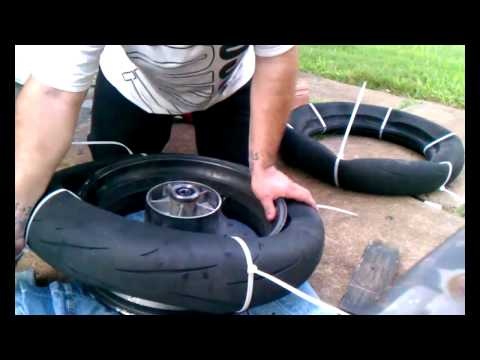 Even thousands of tires later, these things still get me riled up. Beads don’t seat, tires won’t get onto their rims. It's always something. Patient and methodical work gets the job done, so don't get discouraged!
Even thousands of tires later, these things still get me riled up. Beads don’t seat, tires won’t get onto their rims. It's always something. Patient and methodical work gets the job done, so don't get discouraged!
Hello.
Owners of motorcycles with rims have to go to a tire shop to get new tires on their motorcycle. When replacing tires on such motorcycles with your own hands, the disc may bend and lose its presentation. On the other hand, if you have an enduro or any other bike with spoked wheels, it is quite possible to change the tires yourself. Moreover, any normal endurist simply must be able to change tires in the field with a pair of mounts, since off-road trips are often associated with long hauls on asphalt. In this case, it is advisable to go to the place of drowning in mud on road tires, take a set of "evil" rubber with you and put it on a motorcycle in an open field immediately before off-road. Today we will talk about changing the tires of a motorcycle with spoked wheels on your own. nine0003
Today we will talk about changing the tires of a motorcycle with spoked wheels on your own. nine0003
We will talk about the types of motorcycle tires and indices in the names of rubber models, since this topic is worthy of a separate article, and maybe more than one. Today, within the framework of this article, I will give only one of the simplest classifications. Tires for motorcycles are chambered and tubeless. Tubeless tires are convenient, used everywhere on motorcycles with disc wheels. The disk inside is hermetically sealed, so it is enough to put new tires on, smearing the joints with a special sealant, pump up - and you can ride. Spoked wheels are not airtight inside, since the spokes pass through the wheel rim at one end. On spoked wheels, tires with tubes inside are used - it’s clear why. nine0003
Is it possible to put tubeless tires on a spoked motorcycle wheel by simply sticking a conventional tube inside? Yes, easily! Now I will just put tubeless tires with cameras on my motorcycle.
What is the difference between tube and tubeless tires? Everything is very simple. Tubeless tires have a special groove on the inside that acts like a "hook" and increases tightness.
Chamber rubber has no such "hook".
Also, many manufacturers claim that tubeless tires have a reinforced cord. I don’t see anything wrong if we ride a motorcycle with tubes in tires, and even with a reinforced cord 🙂 Especially since there is no difference at all between installing tubed and tubeless tires on a motorcycle 🙂
Let's go!
What you need to change tires on your motorcycle.
To change tires on a motorcycle, we need the following materials and tools:
1) New tires. In my case, the BMW F650GS is the Metzeller Tourance. By default, the Metzeller official website gives the tire sizes specified in the manual for the BMW F650GS motorcycle. Front - 110/90 - R19, rear - 130/80 R17. In principle, there is a lot of space left in front and behind, so I will put 120/9 on the front wheel0 with 19 radius, and I'll leave everything as it should be behind.
2) Crowbars (or crowbars, whatever they call it). I manage alone, but I have experience since Java. Better to use two.
3) Soap solution. It will be needed when putting on new tires, and when removing the old one, it can also come in handy. Without it, you can accidentally break a tire. I know that many people use Vaseline and other neutral lubricants. I don't even know where to buy Vaseline now, so I use soapy water. Soap in water should ideally not dissolve completely and be similar in consistency to snot 🙂
4) Metal cap on the nipple with hooks for unscrewing the nipple.
5) A set of tools to turn the screw nuts.
Do-it-yourself motorcycle tire replacement.
Front wheel example.
1) Loosen the wheel axle while the bike is firmly on the ground.
2) Hang the motorcycle on a stand or put it on the center stand and remove the wheel.
3) Unscrew the nipple and let the air out of the wheel. Then we need to "separate" the rubber from the wheel rim. To do this, you need to stomp her feet. You don't need to jump on it, there is a chance to bend the rim. nine0013
To do this, you need to stomp her feet. You don't need to jump on it, there is a chance to bend the rim. nine0013
There is a little trick here. Sometimes the rubber sticks to the rim tightly. In your garage you can dance shamanic dances with a tambourine, jump on a wheel and separate, but what if you have to change tires in an open field, with a limited number of tools and time?
If you are traveling with a group, the easiest way is to use the side stand of the second motorcycle. Just put the wheel on the ground, fold down the side stand of the second motorcycle and put it on the camera near the wheel rim. Jump like a cutie! 🙂
4) Pry the tire on one side with a pry bar. Be careful not to push the crowbar too deep to avoid tearing the camera.
5) Insert the second mount.
And so on in a circle.
6) Pull out the camera.
And finally disassemble the wheel.
7) Check the condition of the rubber that protects the camera from the spokes. If it is worn or frayed, it must be replaced.
If it is worn or frayed, it must be replaced.
8) Now let's take a closer look at the new tires. We are interested in two markers that are indicated on any rubber. This is an arrow indicating the direction of rotation of the wheel. nine0013
And the marker against which the nipple should eventually be placed. Either two dots or one bold.
9) Then grease the new tire with soapy water.
10) First we push in one bead, then we push the tube inside, aligning the marker against the nipple, then we fence the second tire bead. The camera must be pushed in so that it is not twisted anywhere, otherwise there is a possibility that it will fray itself after a certain number of kilometers. nine0013
11) Done. Put the wheel back on the bike.
With rear wheel by analogy.
How many atmospheres to drive into tires, usually indicated on the pendulum.
Wheel balancing on enduras and choppers is not as important as on sportbikes and other high-speed motorcycles - endurists and choppers usually ride like old grandmas 🙂 But later I will show how to do wheel balancing in handicraft conditions with your own hands. This process is not difficult, and with due patience and experience, you can achieve the same results as with professional equipment. nine0003
This process is not difficult, and with due patience and experience, you can achieve the same results as with professional equipment. nine0003
A couple more moments!
1) Please note that, as in any repair, cleanliness is the key to health! The inside of the tire must be kept clean, because in case any solid particles remain between the tire and the chamber, you have a chance to repeat my Rear Wheel Saga 🙂 I usually blow the inside of the chamber with a compressor and wipe it with a damp cloth.
2) In order not to pinch the camera with the mount, you can pump it up a little. It helps me, and you yourself think. nine0003
All.
This entry was posted in repair and maintenance and tagged BMW F 650 GS, motorcycle, report, repair, photo. Bookmark the permalink.
There is not always a way to call a tow truck, and driving on a flat tire, “chewing” the rubber and killing the rim is at least uncomfortable.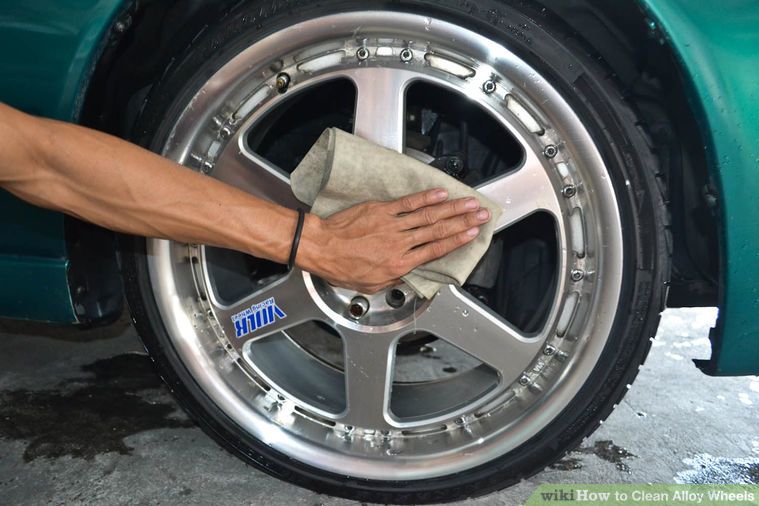
The very first replacement of rubber on a motorcycle or scooter gives reason to think - what is better in terms of quick repairs: tubeless ones that do not require wheel disassembly to eliminate a puncture, but leave the rider helpless if, along with damage, it “led” and flattened the edge of the disc? Or chambers - allowing sealing almost ring breaks (if only there were enough patches), but requiring the removal of rubber from the rim for this? The unequivocal answer is no. Few classics, straights or tourers today remain "loyal" to tube rubber models: tubeless tires are lighter, softer, warm up and cool down faster thanks to simplified heat transfer. In sports, more precisely - enduro and motocross, chamber - on the contrary, prevail: only spoked wheels can "play", withstanding strong alternating loads during landings and impacts. nine0003
The nuance is that a tire with a chamber can be put on any spoked or cast disc, and a tubeless one can only be placed on a cast one, because only it can ensure tightness.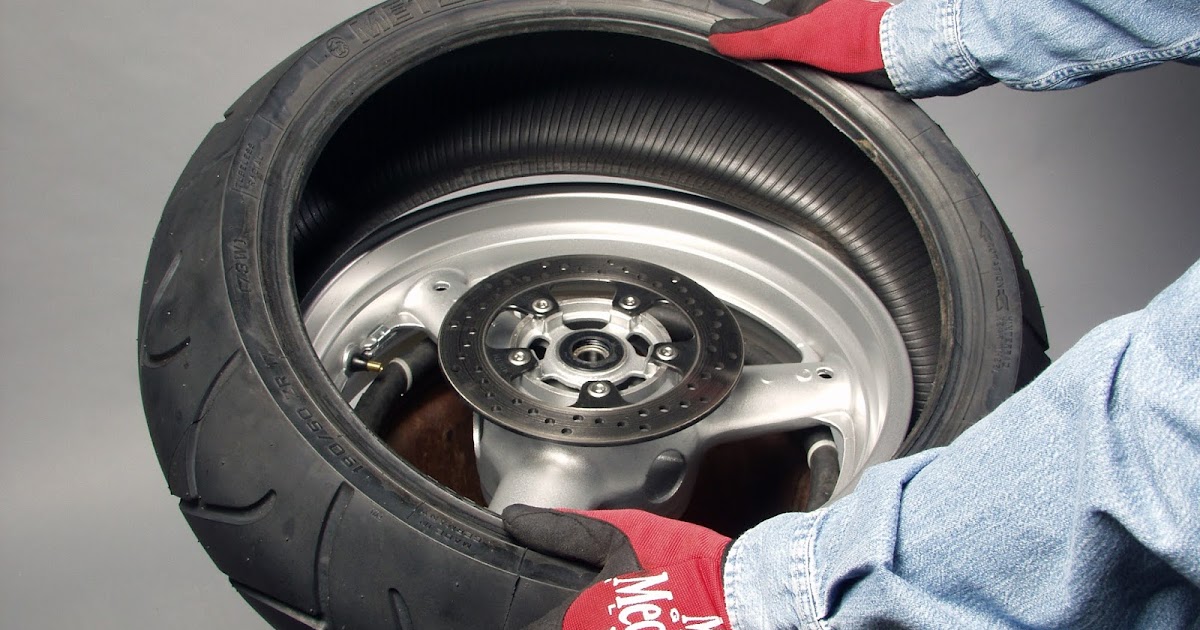 Tube – can be installed in a tubeless tire as an emergency measure. In case of major damage to the sidewall, cracks or curvature of the edges of the rim, this will make it possible, after pumping up the wheel, to reach the nearest tire service (and there already - straightening, balancing and other maintenance according to the rules). True, for such a focus, it is advisable to take a camera with a face value one less than the diameter of the disk, otherwise it will create folds inside that will rub for a couple of hundred kilometers. The resource of such a “treatment” is large - until the next puncture, like a new one. nine0003
Tube – can be installed in a tubeless tire as an emergency measure. In case of major damage to the sidewall, cracks or curvature of the edges of the rim, this will make it possible, after pumping up the wheel, to reach the nearest tire service (and there already - straightening, balancing and other maintenance according to the rules). True, for such a focus, it is advisable to take a camera with a face value one less than the diameter of the disk, otherwise it will create folds inside that will rub for a couple of hundred kilometers. The resource of such a “treatment” is large - until the next puncture, like a new one. nine0003
It depends on the magnitude of the damage whether it will be possible to eliminate it on your own, or whether you will have to “surrender” to the motorized tow truck. In tubeless - holes up to 5–6 mm are patched, in chambers - as much as there is enough glue and patches, the main thing is the condition of the tire. To determine the extent of the disaster - find a place where you can safely stop without violating traffic rules (where it is prohibited - you will have to sacrifice tires and drive on). nine0003
To determine the extent of the disaster - find a place where you can safely stop without violating traffic rules (where it is prohibited - you will have to sacrifice tires and drive on). nine0003
If the wheel deflates slowly, and the object that pierced it is still inside, you can try to carefully drive to the tire shop. A completely deflated "pancake" will have to be resuscitated on the spot, or - remove the wheel and take it to the service.
To find a hole in a tubeless tire, if it is very thin and not immediately visible, the wheel must be pumped up, slowly pouring water - bubbles will go. In place, tubeless tubes can be “harnessed”, or filled with sealant inside, without removing from the motorcycle. nine0003
With the second type of tires - more difficult. A torn balloon must be removed from the tire to detect a defect and seal. In a good way, the wheel must be removed from the motorcycle and disassembled on a clean, flat, hard base. Suppose such a “patch” can be provided even off-road, but how to remove the wheel on a motorcycle if it does not have a central stand? And shooting is not required. The motor must be carefully laid on its side, after making sure that the faucet is closed, gasoline does not flow out through the tank cap (antifreeze does not flow from the tank if the motor is “dropsy”), and removing the plastic or wardrobe trunk with fragile contents (if any). nine0003
The motor must be carefully laid on its side, after making sure that the faucet is closed, gasoline does not flow out through the tank cap (antifreeze does not flow from the tank if the motor is “dropsy”), and removing the plastic or wardrobe trunk with fragile contents (if any). nine0003
You will have to unscrew the wheel from the motorcycle only if you need to replace the tire, or it is decided to patch the tubeless tube with a “fungus”. In the absence of a central stand, this will also have to be done on a lying bike, or - make this stand from improvised materials (bricks, stump, car jack), placing them under the crankcase protection from below, the central tube of the frame, the duplex jumper (but not under the plastic, itself engine crankcase or attachments!), under both footrests - if they are not folding, or - under the pendulum. Before removing the rear wheel on a motorcycle, the front fork must be loaded with something, or an even higher lining is made. nine0003
In a motorcycle tire fitting shop, tubeless tubes are repaired by cold vulcanization. They are removed, disassembled, the puncture site is cleaned from the inside, degreased, lubricated with glue and a calibrated “fungus” patch is inserted into the hole from the inside. The fungus itself is a thin plate of rubber with a “leg” tube in the center. The leg - by the guide wire is dragged through the hole of the damage, and the "hat" seals it.
They are removed, disassembled, the puncture site is cleaned from the inside, degreased, lubricated with glue and a calibrated “fungus” patch is inserted into the hole from the inside. The fungus itself is a thin plate of rubber with a “leg” tube in the center. The leg - by the guide wire is dragged through the hole of the damage, and the "hat" seals it.
After half an hour - you can put the tire back. The reliability of such a repair is high, the patch does not cause a significant imbalance, the service life of a sealed tire does not decrease. nine0003
This method is also applicable on the road, the main thing is to have the necessary equipment and materials with you:
The fungus repair procedure does not require much experience. The main thing is to keep it clean, fully clean the place where the patch fits, let the glue dry slightly to a dull finish and press (roll) the surface of the fungus with high quality, expelling all the air between the layers. If necessary, you can degrease the place before gluing with gasoline, but without the rest of the above, it will not be possible to fully carry out repairs. nine0003
The main thing is to keep it clean, fully clean the place where the patch fits, let the glue dry slightly to a dull finish and press (roll) the surface of the fungus with high quality, expelling all the air between the layers. If necessary, you can degrease the place before gluing with gasoline, but without the rest of the above, it will not be possible to fully carry out repairs. nine0003
The compressor is sometimes replaced by a small cylinder of compressed air or carbon dioxide. Unlike a mechanical pump, it will immediately create a “throw” of pressure, pressing the tire beads against the rim flanges (in emergency cases, even a fire extinguisher was used to pump flat tubeless wheels). When connecting the compressor, start the bike's engine before you start inflating the tire - let it idle. Otherwise, the motor can "land" the battery, and you will not start. nine0003
Manometer - needed for control. It is undesirable to pump over the repaired tire. It is recommended to "inflate" 0.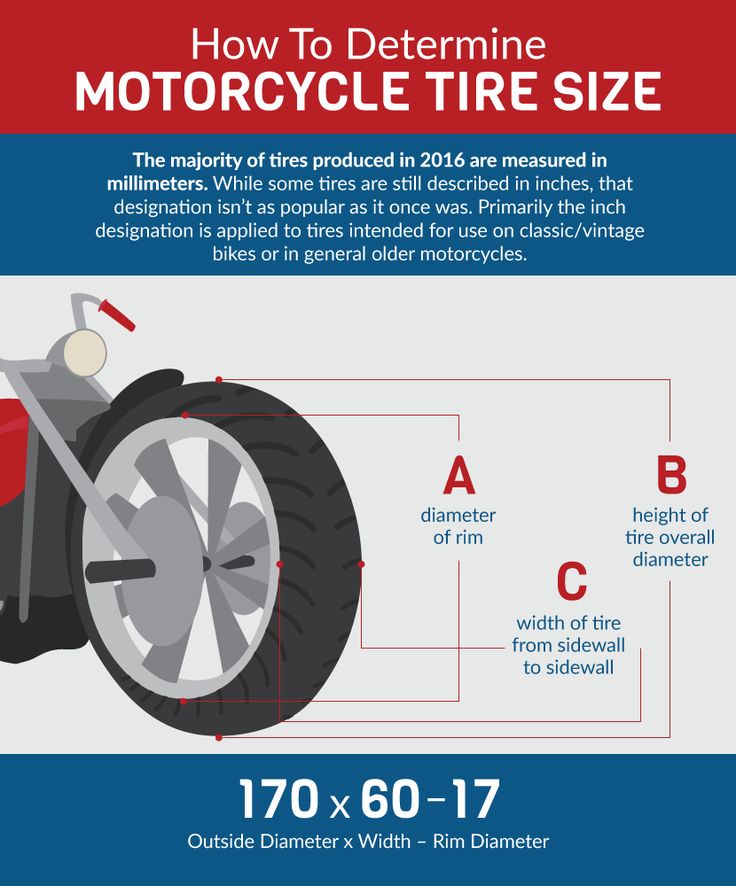 2 atmospheres less than the nominal value. Inflating too little is also bad: a flat tire has a larger contact patch with the road, so the place of a fresh patch will deform more.
2 atmospheres less than the nominal value. Inflating too little is also bad: a flat tire has a larger contact patch with the road, so the place of a fresh patch will deform more.
“Burning” a tubeless tube and sealing its internal cavity through a nipple are quick, simple methods that do not require special skills. To repair the damage, you only need the materials themselves, and how to pump up the wheel. nine0003
Now in Moscow, and not only, 6-5 varieties of cans with a sealant are sold - a quickly hardening "liquid rubber", with a volume of 800 to 250 ml.
Applying "Anti-Puncture" is simple: put a tube with a fitting on the nipple of the camera, turn the can over, and hold the button according to the instructions. Then - pump up the wheel, cleaning the nipple from the foam, roll it, making a full turn to distribute it. nine0003
The sealant is blown out with air into the puncture hole and clogs it, solidifying. After 20 minutes - you can go. Reliability of repair is high. Resource - until the next puncture.
After 20 minutes - you can go. Reliability of repair is high. Resource - until the next puncture.
If you have a compressor, start immediately pumping up the wheel, so it will be easier to work with a puncture, insert a patch, and it will swell faster.
Procedure:
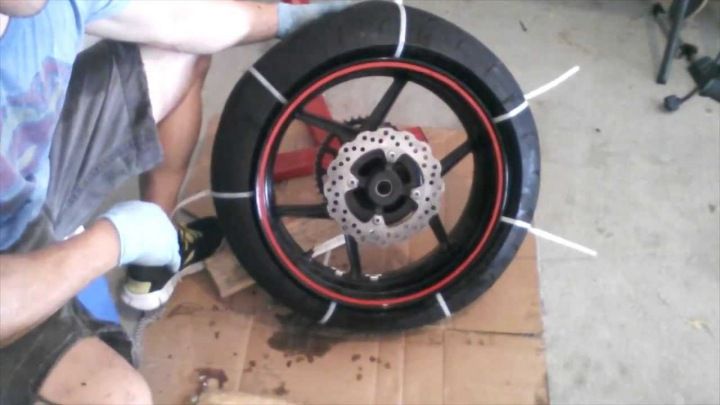
You can go in 5 minutes, you just need to make sure that it doesn’t descend anywhere else.
Outwardly identical, repair kits for harnessing wheels can differ in price by almost half. This variation is explained by different configurations - one will have only three items, the other - six or seven.
A complete tubeless tire repair kit contains:
Regardless of the cost, you need to choose a kit in which the harnesses will be reinforced, and the awl - with a deep spiral winding (notch), and not a “needle file”. Inserting a flagellum is sometimes easier with a regular thin screwdriver. If there is no glue in the kit, or it has dried up, the flagellum is moistened with gasoline. nine0003
If there is no glue in the kit, or it has dried up, the flagellum is moistened with gasoline. nine0003
At motorcycle service stations and car services, holes in the chambers are closed by hot vulcanization: a layer of raw rubber is applied to the cleaned, fat-free puncture site and, after squeezing it well, it is heated with a special “iron”. Iron - burns, layers - are fused into a single whole. Reliability of repair is high. The resource will be almost like a new one.
Cold vulcanization (patching) - used if the workshop is not equipped with a vulcanizer. In this case, the quality of the service and the reliability of the repair will depend on the accuracy of the master. For the convenience of gluing, the camera is completely removed in the service, but, I repeat, this is not necessary. It can be repaired on the spot in the same way (there are no other options except for replacing the camera), but without removing it from the motorcycle.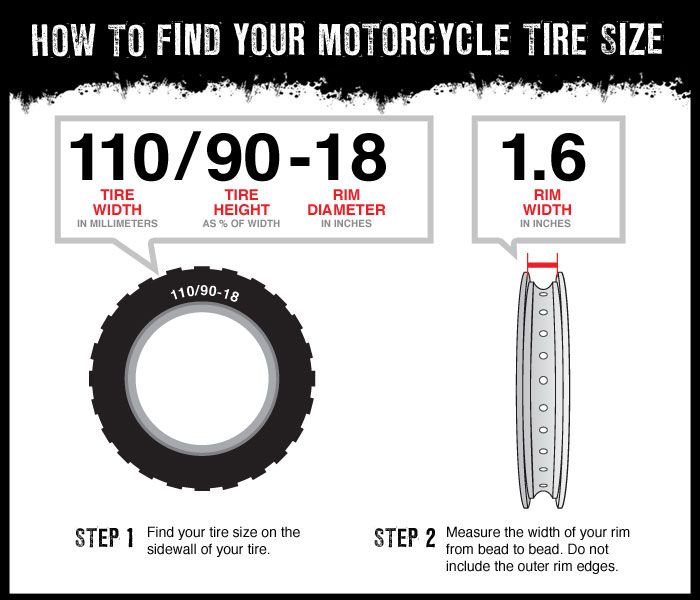 nine0003
nine0003
This can only be done if you have two metal mounting blades. At least one, the second can be replaced with another flat tool. You can still disassemble the wheel with a wide screwdriver and a “family” key wrapped with electrical tape. But this is only as a last resort, otherwise you can damage the cord.
Sequence of work:
 Let the glue dry for a minute. nine0133
Let the glue dry for a minute. nine0133 The fencing must be carried out twice as carefully and more slowly than dismantling, lubricate the side with water or soap, “help” more with your hands, otherwise there is a risk of picking up the edge of the chamber with a spatula and tearing it.
Important! If the wheels of the motorcycle are equipped with tow bars - before pressing the tire bead from the rim, you need to loosen this tow bar! But do not unscrew the nut completely, do not disassemble to the end.
A standard “first aid kit” (a set for repairing classic motor rubber) contains only patches and glue, so it is advisable to supplement it yourself with a piece of “skin” or a needle file. You can degrease with gasoline, or apply a little glue first and wipe off immediately, rolling up the dust with it.
Now there is no shortage of specialized motorcycle workshops not only in Moscow - in all major cities there are motorcycle helpers who help motorcyclists directly on the track, or tow to where you can quickly change the camera, or patch the tubeless correctly, so that there is no trace left. Where there is a guarantee. nine0003
Self-replacement of a tire on a motorcycle requires a certain physical condition, and for the first time - a “kilometer of nerves”. At the service station, instead of you, automation will “sweat”, which will not lock up the board and will not scratch the disc coating with a spatula. The main thing is to do it quickly (if you need to go urgently, the price sometimes does not matter).
At the service station, instead of you, automation will “sweat”, which will not lock up the board and will not scratch the disc coating with a spatula. The main thing is to do it quickly (if you need to go urgently, the price sometimes does not matter).
Repair at the service - may be the only possible one if, due to driving on a flat tire, the tire nipple is turned and torn off. Especially if he flew off and got lost, but there is no spare. In mototiremontazhke - there is always a set of consumables for any wheel diameter. In the same place, in extreme cases, you can buy a new tire, or a used dokatka. nine0003
In addition to the patch, for normal operation of the wheel, balancing must be ensured. This is generally a useful procedure during any change of rubber, otherwise if there is a strong imbalance, the wheel bearing will inevitably break due to vibrations, and the hands will quickly get tired and “buzz” after long rides.
The first couple of tens of kilometers - do not drive, go at the speed of the stream.